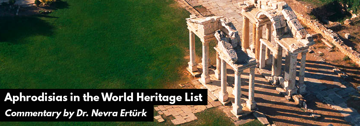KPY
Aphrodisias in the World Heritage List, Commentary by Dr. Nevra Ertürk

October '17
Aphrodisias Archaeological Site, located in Aydın, Karasu, has been included on the world heritage list and taken under protection during the 41st UNESCO World Heritage Committee session in Krakow, Poland.
Turkey's Aphrodisias nomination has been discussed among the new nomination files for the UNESCO World Heritage List, and the decision to inscribe Aphrodisias as a world heritage site has been taken with the support of the vast majority of the Committee members on Sunday (July 9th).
The website of UNESCO Turkey states that the ancient city of Aphrodisias is a “settlement which reflects the unique architectural and urban features of Greco-Roman period in a striking manner” and the most significant attribute of universal value of the city lies in the “deep cultural impact on the Mediterranean Basin, of art of sculptures, composed of the marble extracted from the quarries in the area and worked by local schools”.
The wealth of both the ancient city of Aphrodisias and the surrounding northern regions come from the marble quarries existed in the area. Several large civic structures, such as theatre and bath complexes made from marble exist in the ancient city, including the best-known temple of Aphrodite, which dates from the 3rd century BC.
With the inscription of Aphrodisias to the UNESCO World Heritage List, the number of inscribed properties in Turkey has increased to 17.
Göbeklitepe Archeological Site will be the next candidate property of Turkey to be nominated for the 42nd session of the World Heritage Committee (2018).
Commentary by Turkish National Commission for UNESCO member Dr. Nevra Ertürk
 In the 41st Session of the UNESCO World Heritage Committee, held in Krakow, Poland in July, Aphrodisias has become the 17th heritage site of Turkey inscribed on the World Heritage List.
In the 41st Session of the UNESCO World Heritage Committee, held in Krakow, Poland in July, Aphrodisias has become the 17th heritage site of Turkey inscribed on the World Heritage List.
The World Heritage List has been active since 1976 and, as of 2017, the number of cultural and natural heritage sites inscribed on the List since 1978 has been 1073. With the UNESCO World Heritage Convention of 1972, the concepts of "world heritage", "cultural heritage" and "natural heritage" have started to be used more often; the international collaborations for protecting the universal heritage have been further encouraged by UNESCO World Heritage Center.
The list represents heritages carrying outstanding universal values predominantly in the cultural category, within which archeological sites and religious monumental architecture are outnumbered. Especially in recent years, the World Heritage Center and the Committee have been trying to keep a balance of representation in the List. During this period, while parties with none or few heritage sites are encouraged to be represented, presentation of heritage sites in different categories has also been recommended. Natural heritage, cultural landscape, modern architecture, industrial heritage, pre-historic settlements are proposed assets/areas to be inscribed in the list; and the presentation of the serial and cross-border nomination files is also encouraged.
Aphrodisias, inscribed in the List within the Cultural Category, is one of the examples of Greco-Roman settlements found in the World Heritage List. First things that comes to mind about Aphrodisias; The Aphrodisias sculpture school, the sculptors raised in this school and their works, and the Aphrodite cult. However, the outstanding universal value declaration of the heritage site does not consist solely of these elements. Essentially, the heritage site consists of two complementary components. These are; the ancient city surrounded by historic fortified walls and the marble quarries located in the northeast of the city. The connection between these two components is the breakpoint of the universal value declaration. The authenticity and integrity of the site, conservation status, a well-prepared administration plan, excavations and research studies that have been conducted since 1961 can be listed as the further outstanding features of the heritage site. The conservation work carried out with great care by the Area Presidency and the Excavation Presidency, the support from Geyre Foundation both on the renovation project of the museum and on the archaeological site help increase the value of the area.
The process after being inscribed on the List, requires more rigorous and intensive work for each heritage site. My wish is that the administrative system, under the coordination of the Site Authority, carries on with a participatory and inclusive approach ensuring the sustainability of all values, authenticity, integrity and conservation status of the area of heritage.
(KPY, 2017)